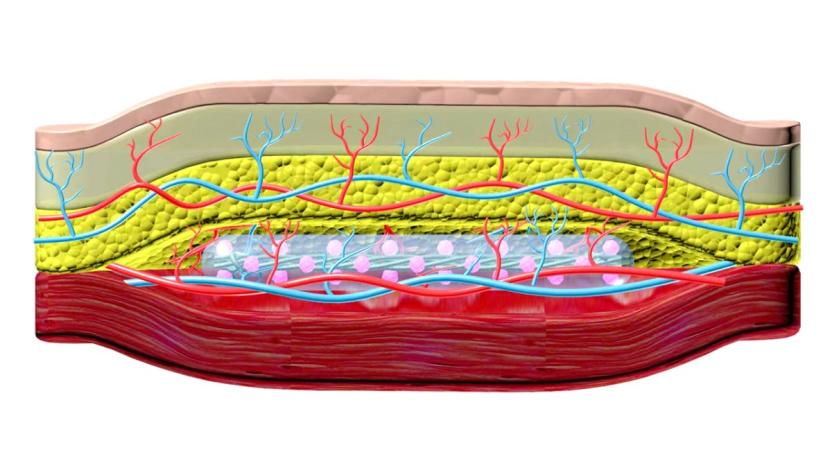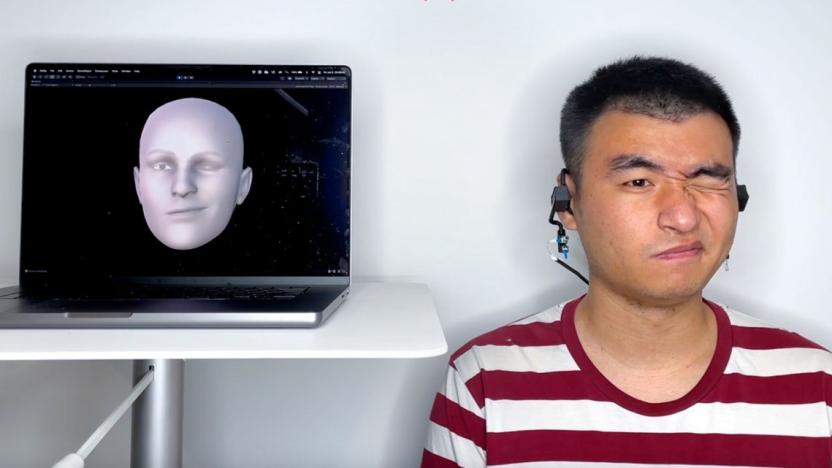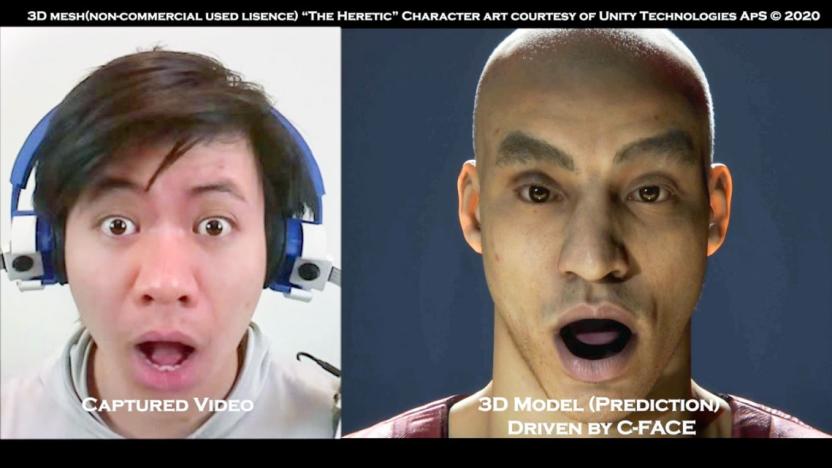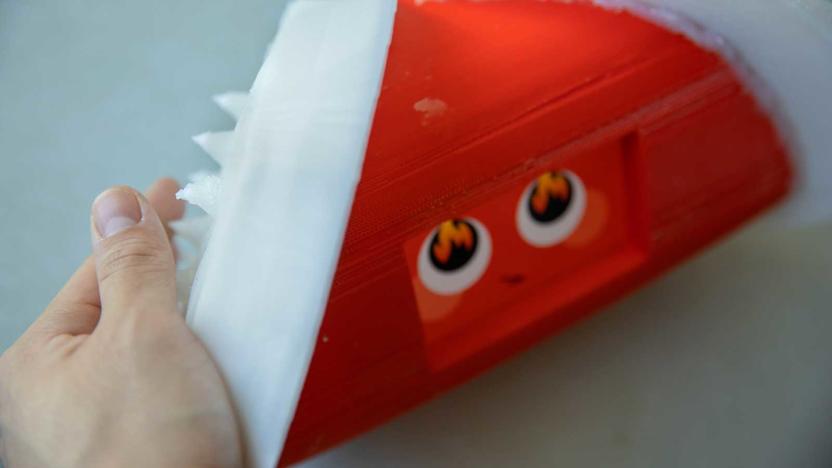cornell
Latest

Researchers develop under-the-skin implant to treat Type 1 diabetes
Scientists have developed a new implantable device that has the potential to change the way Type 1 diabetics receive insulin.

Researchers built sonar glasses that track facial movements for silent communication
A Cornell University researcher has developed sonar glasses that “hear” you without having to speak.

Researchers made a sonar-equipped earphone that can capture facial expressions
The 'earable' bounces sound off the inside of the wearer's cheeks to detect face movements.

Cornell researchers created an earphone that can track facial expressions
The team says C-Face works even when the subject is wearing a mask.

Emotional robot uses goosebumps to show how it's feeling
Sure, a robot can show how it's feeling (insofar as a robot can feel) with its face, but that's not the only way living beings do it. Humans have their goosebumps, for instance, while cats and dogs will raise their fur. Cornell wants to bring that nuance to synthetic beings. Its researchers have crafted a robot that uses a soft, adjustable skin to provide a tactile indication of a robot's emotion -- as the university put it, you can feel its feelings. It may develop goosebumps if it's happy, spikes if it's angry, or just a timid response if it's sad and needs a hug.

Science shows that anyone could become an online troll
It's easy to dismiss internet trolls as freaks. Surely they weren't raised well, right? Don't be so quick to judge. Cornell and Stanford researchers have published a study suggesting that anyone can engage in trolling if the circumstances are right. In an experiment, the schools skewed the moods of participants by making them complete either very easy or very difficult tests. They were then unleashed on the comment sections of online articles, some of which had trolling posts... and, well, you might have a hunch as to what came next.

ICYMI: Raining tiny satellites and the laundry-folding machine
Today on In Case You Missed It: A company called FoldiMate is selling a standalone machine to sit alongside a washing and dryer and fold about 20 garments at a time for $850. Cornell University engineers are sending tiny interstellar computers to the ISS this summer, there they will act as satellites and, eventually, collect information from our nearest neighboring star system, Alpha Centauri. We also round up the week in our TL; DR segment. If you grew up playing The Sims, this piece of news might interest you. We're also very interested in the Visa payment ring the Olympic athletes can wear in Rio. As always, please share any great tech or science videos you find by using the #ICYMI hashtag on Twitter for @mskerryd.

The After Math: Potpourri
It's been a mixed week for news with few clear winners and losers -- outside of Chewbacca Mom of course, who has been killing it. Let's see, Takata had to recall 12 million more airbags because they keep killing people. On the other hand, MIT managed to double the efficiency of solar cell technology. Foxconn announced that 60,000 people would get the sack in favor of automated assembly machines but Cornell doctors discovered a better way to predict your chances of coming out of a coma -- just like Steven Seagal. Best of all, Florida Man strikes again! Numbers, because everything is shit except for the half of it that isn't.

Scientists confirm a cornerstone of quantum computing
Quantum physics theory has an odd but fundamental quirk: atoms in a quantum state aren't supposed to move as long as you're measuring them. It sounds preposterous, but Cornell University researchers have just demonstrated that it's real. The team noticed that the atoms in an extremely cold cloud of Rubidium gas wouldn't move around as long as they were under observation. The more often scientists used a laser to measure the behavior, the less movement they saw. They had to either tone the laser down or turn it off entirely for the atoms to shuffle around freely.

ICYMI: A cold foam heart, fast oil change invention and more
#fivemin-widget-blogsmith-image-524051{display:none;} .cke_show_borders #fivemin-widget-blogsmith-image-524051, #postcontentcontainer #fivemin-widget-blogsmith-image-524051{width:570px;display:block;} try{document.getElementById("fivemin-widget-blogsmith-image-524051").style.display="none";}catch(e){}Today on In Case You Missed It: Castrol invented an oil-storing apparatus that lets you change the oil and filter by swapping in a fresh container under two minutes. It's already inside an Aston Martin racing car but the company's goal is to get it into mainstream consumer cars within a few years. Meanwhile Cornell scientists invented a polymer that has pores and can pump fluids, allowing it to act as an artificial foam heart. And a Tokyo-based eyewear company will begin selling its smart glasses next month. The classically-styled eyeglasses can track movement and are definitely less nerd-defining than the telltale Google Glass version.

Scientists make an artificial heart out of foam
Artificial hearts only kinda-sorta behave like the real thing. They pump blood, sure, but they're typically solid blocks of machinery that are out of place in a squishy human body. Cornell University thinks it can do better, though: its scientists have developed an artificial foam heart that imitates both the functions and shape of its fleshy counterpart. The key is a new polymer that can be poured into specific shapes, and has pores that let it pump fluids. It's not only soft and stretchable, but more efficient -- you don't need much energy to get liquids moving.

Graphene kirigami could lead to flexible, nanoscale machines
Graphene's looking more and more like an all-around wonder material that can be used to make armor tougher than kevlar, thin light bulbs, long-lasting batteries and even high-tech tattoos. Now, a team of Cornell physicists have discovered that they can make kirigami out of 10-micron sheets (a hair strand's 70-micron-thick, for comparison) of graphene, as well. Kirigami is the art of cutting out designs on a single piece of paper like in the image above. The ones made by the Cornell team are much, much smaller -- they're quite literally nanoscale versions of what you see above -- but since they're made of the wondrous one-atom-thick material, they're also incredibly strong.

3-atom-thick transistor promises ultrathin electronics
Researchers from Cornell University announced a breakthrough in transistor technology in the latest issue of the journal, Nature. The team has reportedly developed a novel and highly efficient method of producing an experimental material known as transition metal dichalcogenide (TMD). TMD is an exceedingly thin (but highly conductive) film, which makes it useful in many high-tech applications -- everything from solar cells to flexible, wearable gadgets -- but also makes it a huge pain to produce in appreciable quantities. That is, until now.

Scientists can build an early-warning system for trolls
Almost every website with comments suffers from trolls, people who like to spout obnoxious and irrational gibberish just to offend others. Since you can't just ask people to behave like human beings, a lot of time and effort is spent monitoring and policing this idiocy. Thankfully, the internet's long national nightmare may now be at an end after researchers from Stanford and Cornell developed an early warning system for trolls. After conducting a study that examined close to 40 million comments, it was found that trolls can be algorithmically identified before they've written 10 posts.

Car safety system monitors your body language to prevent accidents
Many collision avoidance systems watch out for other cars or pedestrians to keep you safe. But this new one called Brains4Cars being developed by Cornell and Stanford University researchers adds a camera that monitors you (or the driver's, if it's someone else) body language, as well. The computer that's watching you on cam can detect your face and head movements to find cues on whether you're turning or changing lanes. With data from a radar and another camera keeping an eye on the environment, the system can warn you if it's too dangerous to turn.

Cornell student's graduation cap sports super-bright LEDs that attendees control from the web
At university graduations, students often deck out their academic regalia with glittery text and other shiny objects to help family members identify them among the crowd. As you might expect, the design sophistication can vary depending on the youngster's major, but at Cornell this year, one scholar clearly stole the show. Jeremy Blum, the proud new owner of a master's degree in electrical engineering, one-upped his classmates with Control my Cap, a WiFi-connected headpiece that packs 16 350mA high-brightness LEDs. Blum installed four red, green, blue and white LEDs in a clear light diffuser attached to his stock grad cap using a 3D-printed holder. He then embedded a Raspberry Pi computer and a $20 Adafruit LCD module with keypad within a wrist-mounted holder he printed with a MakerBot Replicator. Finally, a simple mobile site served as an interface for attendees, who could submit colors for the cap to display. We bet his professors are very proud.

Eyes-on with Cornell University's laser tag dunebots (video)
Cornell University may be the host of the Cornell Cup competition, but that doesn't mean it can't bring its own robots to join in on the fun. This year, students brought along a few bots, dubbed dunebots, outfitted with all-terrain wheels and equipped with laser tag turrets. The rugged rig features a pair of cameras, a dustproof and water resistant chassis, air intakes capped with filters, and other components for suspension and steering. Not only does the team plan on releasing code and documentation for the project, but the hardware was designed with modularity in mind, so others can build their own modified versions. Taking the robot into battle requires two pilots armed with Xbox 360 controllers: one directing where it travels, and another aiming the turret and firing. Driving the buggy over the web is also possible, though it takes a few seconds for it to react. The group also baked in voice controls, to boot. If you're not watching the car duke it out in person, you can even tune in over the web and watch a live video stream from one of its onboard cams. Its top speeds haven't been firmly nailed down, but the team says the bot was running at approximately 35 percent of its full potential, since it was deemed too fast for conference attendees. Hit the jump to catch us talk with the effort's Computer Science lead Mike Dezube, and to see a dunebot in action.%Gallery-187525%

NY approves Cornell Tech's applied sciences campus on Roosevelt Island
While Cornell has given its researchers the resources to build spider-like robots and move Pong paddles with the power of the mind, students more interested in the software side of engineering have not been getting as much love. That's about to change, however, with the recent City Planning Commission approval of Cornell Tech, a project to build an applied sciences campus on New York City's Roosevelt Island. Now the next step would be to get a blessing from the City Council. After all is said and done, we'll hopefully see the 12-acre site break ground in 2014, the campus opening its doors in 2017 and a full build-out by 2037. As they await their new home, Cornell is holding classes for aspiring computer whiz-kids at Google's Chelsea campus, where we're sure they'll get an inspiration or two. To see what else Cornell Tech has in store, check out the source link below.

Cornell scientists 3D print ears with help from rat tails and cow ears
Science! A team of bioengineers and physicians over at Cornell University recently detailed their work to 3D print lifelike ears that may be used to treat birth defects like microtia and assist those who have lost or damaged an ear due to an accident or cancer. The product, which is, "practically identical to the human ear," according to the school, was created using 3D printing and gels made from living cells -- collagen was gathered from rat tails and cartilage cells were taken from cow's ears. The whole process is quite quick, according to associate professor Lawrence Bonassar, who co-authored the report on the matter, "It takes half a day to design the mold, a day or so to print it, 30 minutes to inject the gel, and we can remove the ear 15 minutes later. We trim the ear and then let it culture for several days in nourishing cell culture media before it is implanted." The team is looking to implant the first ear in around three years, if all goes well.

Researchers turn to 19th century math for wireless data center breakthrough
Researchers from Microsoft and Cornell University want to remove the tangles of cables from data centers. It's no small feat. With thousands of machines that need every bit of bandwidth available WiFi certainly isn't an option. To solve the issue, scientists are turning to two sources: the cutting edge of 60GHz networking and the 19th century mathematical theories of Arthur Cayley. Cayley's 1889 paper, On the Theory of Groups, was used to guide their method for connecting servers in the most efficient and fault tolerant way possible. The findings will be presented in a paper later this month, but it won't be clear how effectively this research can be applied to an actual data center until someone funds a prototype. The proposed Cayley data centers would rely on cylindrical server racks that have transceivers both inside and outside the tubes of machines, allowing them to pass data both among and between racks with (hopefully) minimal interference. Since the new design would do away with traditional network switches and cables, researchers believe they may eventually cost less than current designs and will draw less power. And will do so while still streaming data at 10 gigabits per second -- far faster than WiGig, which also makes use of 60GHz spectrum. To read the paper in its entirety check out the source.












